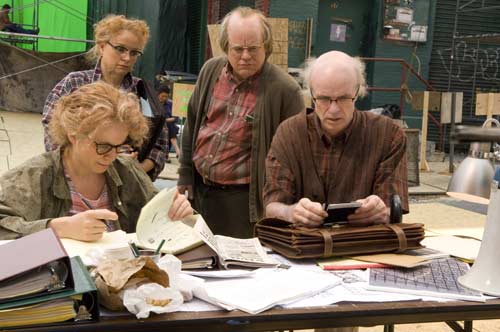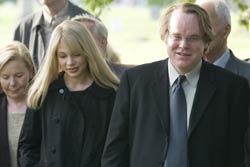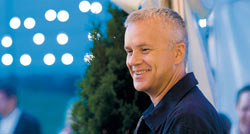
Ah, Toronto. I only come once a year, and then I spend more time in dark rooms than roaming the city, but the very word ‘Toronto’ inspires anticipation and delight. For a film critic, it means a festival lasting ten days in early September, and that means movies--30, 40, even 50 of ‘em, depending on your stamina. I’ve been going six years now, and some of my favorite films of the decade are ones I saw here first: 4 Months, 3 Weeks, and 2 Days; You, the Living; Still Life/Dong; Be with Me; Tropical Malady; and Shara.
Waltz with Bashir won’t crack that list, but it’s close. It’s an animated documentary--an unusual combination--done in a style that recalls a cross between Richard Linklater’s Waking Life and certain graphic novels. Writer and director Ari Folman attempts to reconstruct what happened during the infamous 1982 Sabra and Shatila massacre. Folman was an Israeli soldier when Israel invaded Lebanon. Three months into the invasion, the Lebanese Phalangist party entered the Palestinian refugee camps and slaughtered hundreds of refugees. Whether the Israeli army was complicit in the killings has always been disputed. Israeli soldiers were surrounding the camps, but it’s unclear how much they realized of what was going on, though later an Israeli government commission found General (later Prime Minister) Ariel Sharon “personally responsible.â€
What propels the film is Folman’s inability to remember what happened beyond a strange dream he keeps having (rendered in gorgeous yellow-hued animation in the movie). Wondering why he can’t remember, he approaches his psychiatrist, who encourages him to explore his dreams and memories by interviewing fellow soldiers who might’ve been in Lebanon with him. Those conversations were originally shot on film and then animated by Yani Goodman. These are intercut with scenes that Forman remembers of his time in Lebanon, including various battles and, in a moment that consciously evokes Apocalypse Now (the mother of all Jungian war films), surfing.
The animation works nicely with the Jungian/Freudian imagery on display, giving the entire film an archetypal quality. That threatens to minimize the horrors of war, but Folman always knows when to pull back, when to allow the details of an interview to ground the material. Only an unnecessary porn tape interlude breaks the spell. The film’s soundtrack, however, is particularly effective, both in its use of effects and music. And the movie’s exploration of memory, history, and imagery is provocative and compelling, reaching its zenith at the climax, a montage of staggering power.
Another film that explores the intersection of art and psychology is Synecdoche, New York. Charlie Kaufman is the screenwriter of such mind-bending films as Being John Malkovich, Adaptation, and Eternal Sunshine of the Spotless Mind. So it’s no surprise that his directorial debut is just as strange, if not stranger. It stars Philip Seymour Hoffman (always a good thing) as Caden Cotard, a theater director who’s obsessed with his own mortality. But when he receives a MacArthur “genius grant†at the same time his wife (Catherine Keener) leaves him, Caden decides to create a theater work for the ages. That preparations for the piece go on for decades and involve hundreds of cast and crew seems relatively normal compared to everything else in the film.
How much you enjoy Synecdoche depends on how willing you are to follow Kaufman wherever his obsessions take him. In this case, that includes several people performing as Caden Cotard (including a game Dianne Wiest), a hilarious sequence of a house perpetually on fire, and lots and lots of word play (“is that right as in morally correct or as accurate?â€). The movie is a wide-ranging (some might say unfocused) exploration of the relationship between art and life. Now that Kaufman is a director, this means almost every character finds a way to give or take direction. I have no idea what it all adds up to, but the sheer audacity on display can be thrilling at times, and the strong cast--including Samantha Morton, Michelle Williams and a welcome performance from Tom Noonan--helps carry the dense material.
A solid set of performances is what saves The Lucky Ones from its ridiculous screenplay. The latter includes a tornado, a dysfunctional penis (those are related, by the way), and an RV out in the middle of nowhere filled with beautiful sex workers. I guess I need to get out more often.
How this got past even one script editor is beyond me. Fortunately, Tim Robbins, Michael Pena, and Rachel McAdams make for a likable trio of soldiers on leave from the war in Iraq and on a road trip across America. I was worried at first that McAdams was going to be a bit too cute, but she grew on me over the course of the film, and Robbins thankfully gives one of his no-twitch performances. Again, I’m not sure what this adds up to (particularly whether it’s saying anything about our contemporary culture--I suspect it’s not), and you have to overlook a lot of absurdities, but I’ve seen worse.
In fact, I’ll probably see worse in the next ten days of Toronto, but hopefully not too much. I plan on blogging every weekday and maybe a weekend day or two as I watch 40+ films. Check back here for updates. You can also read dispatches from my Plastic proprietor partner Rob Davis here. Your comments are always welcome. Thanks for tagging along.






